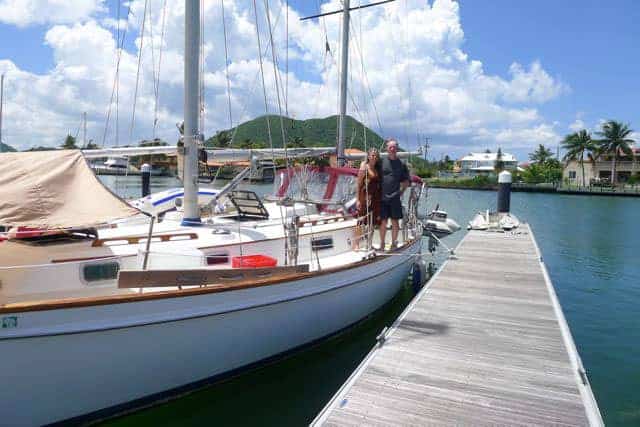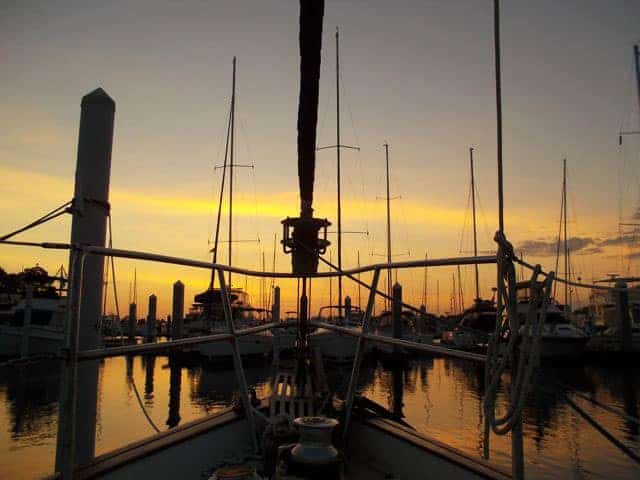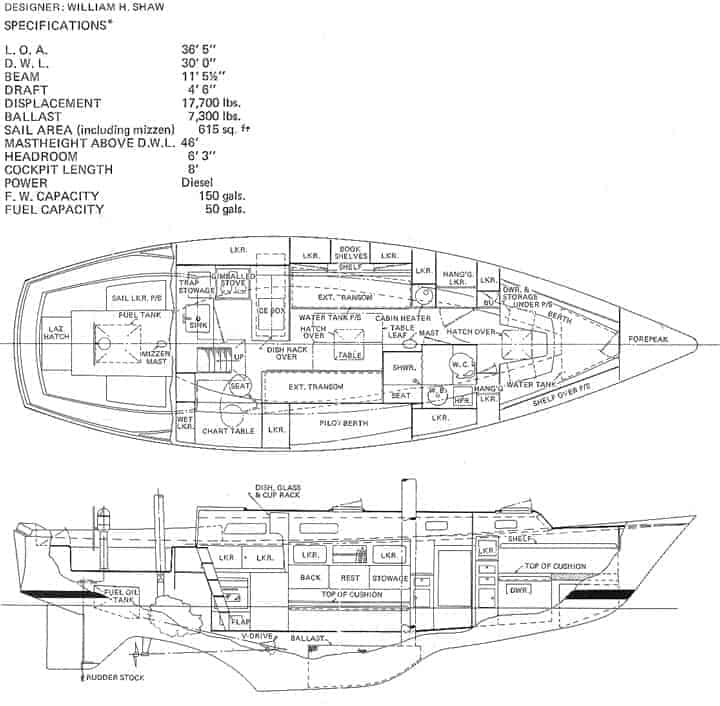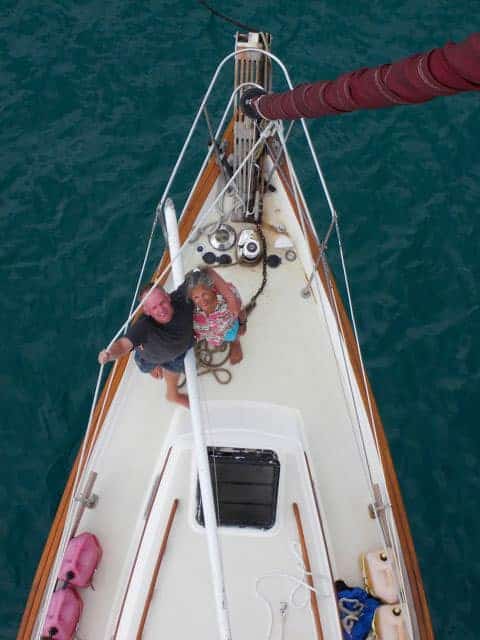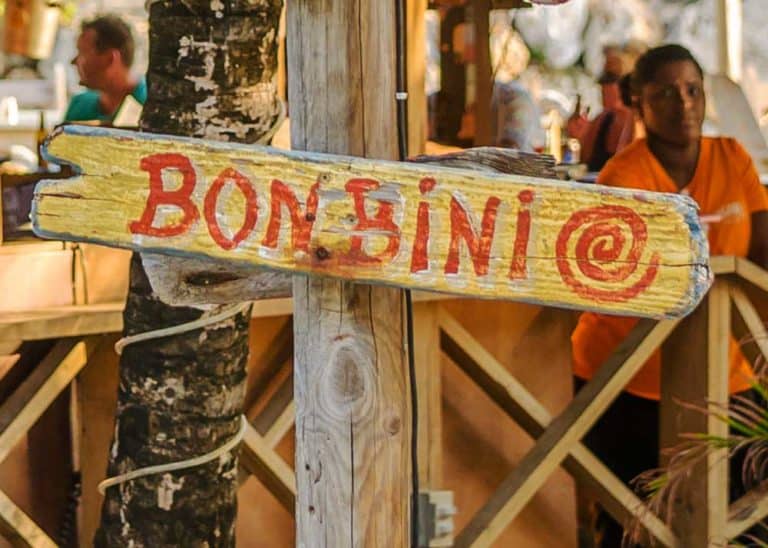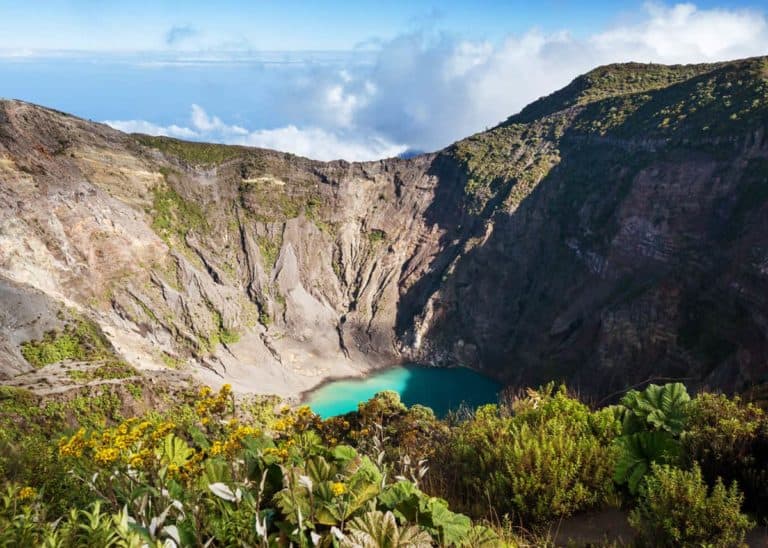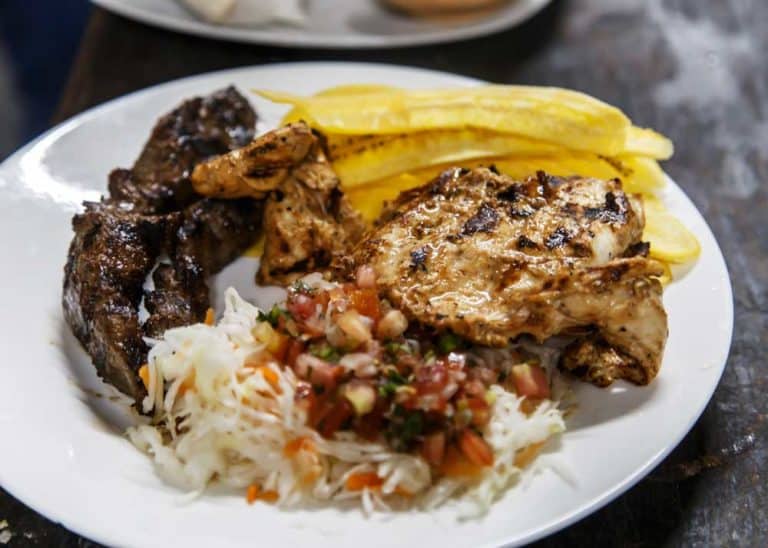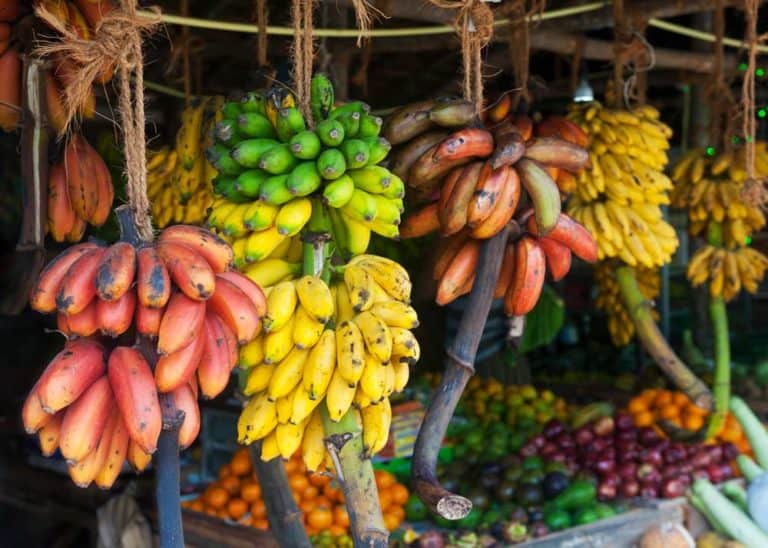Our Cost of Living: Sailing Around the World (Dana Greyson)
Interested in the cost of living about a sailboat while cruising around the world? It is surprisingly inexpensive. Dana Greyson and Wayne Seitz (GalleyWenchTales.com) are experienced sailors and share all their specifics in this details cost of living post. Lets get started…
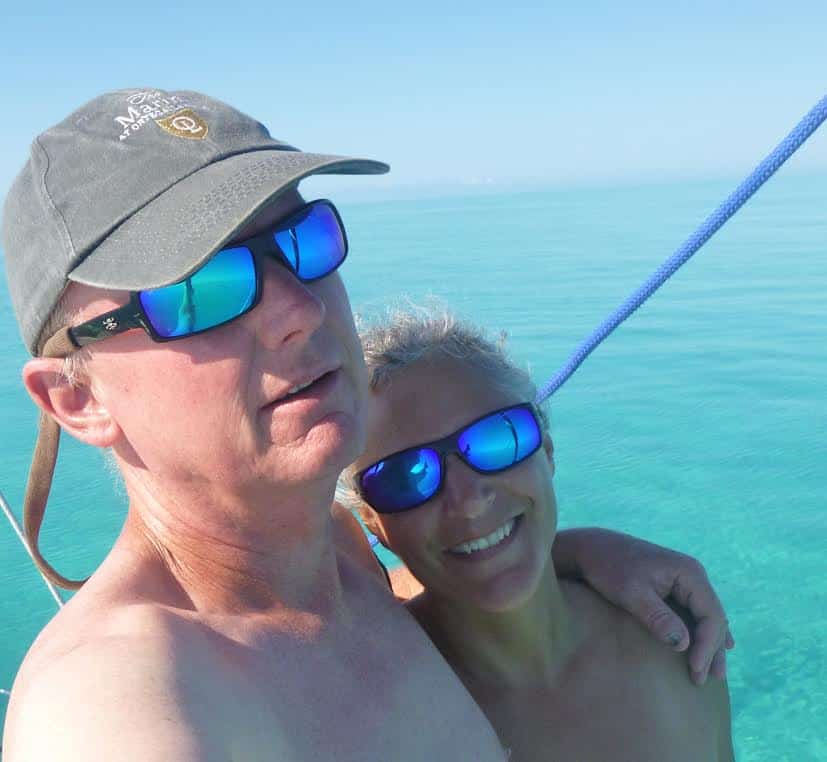
We paid $30,000 cash for our cruise-ready 1977 Pearson sailboat; we bought it because they’re renowned for their seaworthiness and durability.
While it’s designed for couples, at 36 1/2 feet, or about 150 square feet of living space inside our cabin, a fellow Pearson owner quips, “There’s two rooms on a Pearson: inside, and outside.” It’s small, by modern cruising standards, with much better storage capacity than most new boats, which are more often designed for weekends or week-long charters, rather than real living aboard the boat.
Regardless, while our cabin home is small, we have one heckuva big backyard!
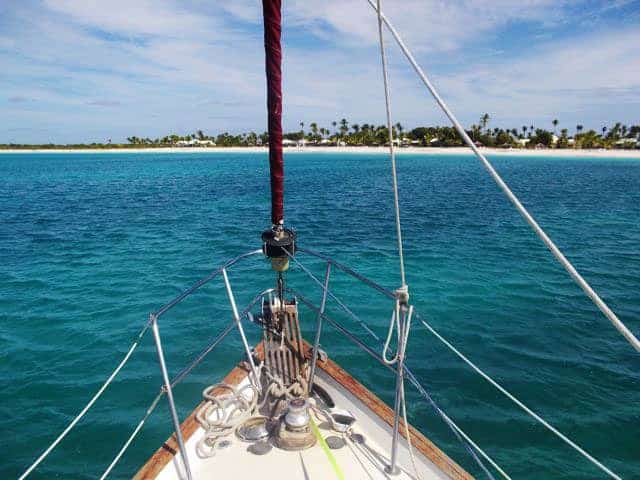
Our primary expenses are maintenance, food, fuel, sometimes mooring and water and once in a while transportation, entertainment, and emergencies.
Thus far, we’ve just traveled in the Caribbean. We’re in Florida right now (expensive – working here over hurricane season and not getting ahead), though we’re headed to the South Pacific after hurricane season, with a goal of finishing our travels in Australia, selling our boat there (the market for them is better), than deciding where in the world to settle.
Our cost varies by country and circumstance; we’ve traveled to:
- St. Lucia (where we bought our boat)
- Martinique
- Dominica
- Guadeloupe and “The Saints”
- Antigua and Barbuda
- St. Martin
- St. Barts
- British Virgin Islands
- US Virgin Islands and Puerto Rico (and “The Spanish Virgins”)
- Nevis and St. Kitts
- Saba
- Bahamas
- Stacia
Our first year we didn’t spend much on fuel, but spent a lot fixing things on our boat.
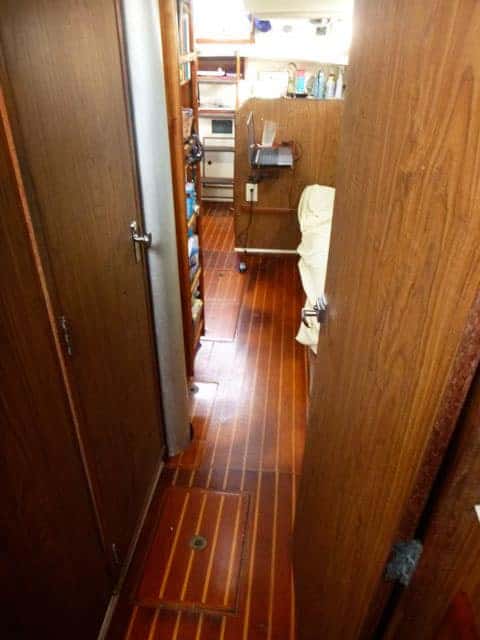
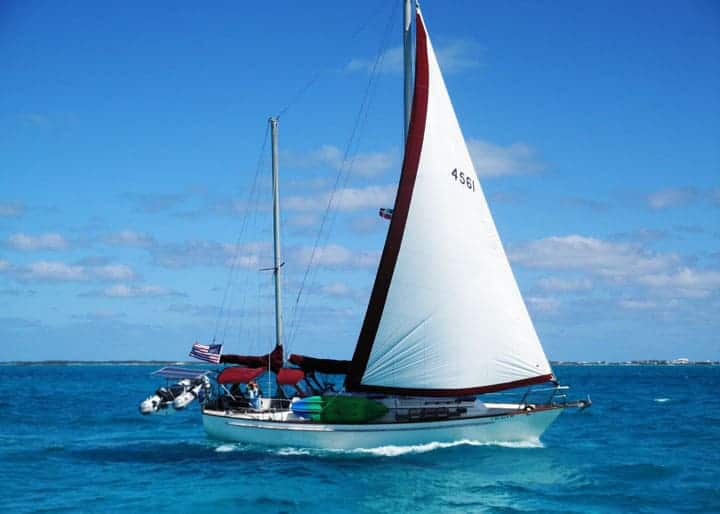
Our average budget goal is $1500/month for everything when we’re cruising.
There are some cruisers who subsist on beans and rice and rice and beans and are much better at fishing or bartering than us only ever drop anchor, never pay to stay anywhere.
They might get by for as low as $500/month, if they’re lucky and travel only to inexpensive places.
Others spend much more than us, eating out, spending on tours, flying home a few times a year, staying in marinas or on paid more balls much more often, maybe even all the time. They’re likely spending $2,500/month and up.
Our Typical Monthly Cruising Expenses – $1500 Breakdown
- Lodging: $75 Most of the time we pay nothing for lodging; we simply drop our anchor. For the rare time we stay on a mooring ball they’re usually $15/night. Marinas, $50-100.
- Electricity: $0 – $5 We use solar and our engine’s battery for most of our electricity, and sometimes run a small gas powered generator when we’re not getting enough sunshine and are lucky enough to sail on wind-power alone, which means our batteries don’t have as much juice to share. We don’t have a wind generator because it’s hard to find one to fit on our boat and they’re expensive.
- Land Transportation: $100 We’ve rented cars in places like the French territory of Guadeloupe for $35/day + gas. Bahamas outer islands ran more in the $80-$100 range, though we split the cost with another couple. Places like St. Lucia were over $100, and drivers were crazy, so we took the local’s bus when walking wouldn’t do, generally for $1.50 or so each way. Generally bus fares seem to range between 75 cents and $3 — when they’re an option.
- Water: $5 Usually we made our own with a small watermaker, which de-ionized seawater. There is some cost for when we paid to fill our 100 gallon tanks or some some cost for using gas when we didn’t have the solar or motor power to make it for “free.” Water in the Bahamas cost as much as 50/cents gallon, in some other places, it’s free.
- Garbage: $0-$10 Some items are ok to set adrift or sink, depending on what and where. Organic matter that’s safe for marine life, for example, or metal cans in very deep water. Where there are free public dumpsters, we use them. Other place, we may need to pay $2-$5 for a smallish bag to be disposed of, we hope properly.
- Phone: $40 Varies widely from nothing — we don’t use a phone, to a phone card for $15 that lasts a while, to $50-$60/month between the two of us.
- Internet: $30 Best deal, other than free, was the Bahamas BTC 2.5 GB monthly data plan, when the cards were half off the regular $30 price; coverage was surprisingly decent, though we weren’t going to stream movies. We probably spent more than this on what we ate or drank at pubs to access their WiFi, even though we were pretty frugal (we could consider this eating out). It’s become infrequent to access signals outside of their business (despite an amplifying antenna, even if we have the password); guessing that’s deliberate.
- Mail: $15 We pay someone back in the States to manage our mail.
- Gas / Diesel: $100 The least was a marina special is St. Martin, $1.20/gallon, the most $5.71/gallon. Our first year we traveled 1,600 miles on 60 gallons of diesel over 8 months — less than $300. Last cruising season we spent $800 in 8 months, traveling probably about half the distance. Throw in another $25/month for when we’ve rented a car and blitzed an island.
- Propane: $10 For cooking; refilling our tanks every 3 months or so.
- Food: $500 This is complicated a bit by a gluten free diet. As much as we can, we stock up on cheap and hard to find perishables when we can. In the States, we spend about $500/month a mix of scratch cooking ingredients, fruits and veg, and snacks, especially nuts, Fritos and thin rice crackers. A $3 bag of Fritos will sell for $6-7.50 in the Bahamas. Bad as that sounds, we embraced local food whenever we could, for the novelty, for freshness, and to save money.
- Meals Out: $80 We rarely eat out. Road food seems to run $7/up/person, restaurant $15/up/person for food and one drink each. A special birthday meal of lobster and another entree and a couple drinks in a moderate sit-down restaurant $50-$100.
- Booze: $30 Buying what’s reasonable, like an off-brand bottle or rum or gin, and making our own mixers. No more beer on a gluten-free diet!
- Medical: $45 We don’t currently carry insurance other than $60 Diver Dan, for a medical advice line and emergency transport. To treat “trigger finger” it cost $420 for an orthro visit with a cortisone shot in Antigua, and $80 for a similar treatment at a generalist in St. Thomas, USVI. Mostly, we’re healthy, lucky and hold off on whatever we can while we’re cruising. We are looking at what to do for preventative care and emergencies as we realize this approach is not the best.
- Customs: $50 This ranges from noting, to as much as $300 for a 6 month cruising permit with fishing rights included in the Bahamas.
- Misc: $410 The rest…. boat expenses, picking up a trinket, personal care such as lots of sunscreen and insect repellent, clothing, waterproof backpack, entertainment (usually free – a walk, a swim, a snorkel, hanging out on a beach, watching movies we’ve downloaded or swapped with other cruisers, free books from a book exchange)…. This can also include big unexpected expenses like replacing our dinghy (the little boat that we use to get from our boat to shore and back) and its outboard motor, to redoing all our rigging lines somewhere expensive because they started breaking.
Our first year we spent more, which is typical when buying a “new” boat; our second year we spent less.
Next year we’ll have some big expenses associated with the cost of traversing the Panama Canal and for breaking up a huge ocean voyage by stopping at Galapagos, which is very expensive.
We’ll spend nothing, though, in the middle of the ocean — can’t buy anything there even if we want or need it!
Want to Learn More about Sailing?
- Beth Leonard’s The Voyager’s Handbook: An Essential Guide to Blue Water Cruising is the most down-to-earth, yet comprehensive recent resource we’ve seen for anyone trying to decide whether cruising is for them and what’s involved, including and what goes into different levels of cruising budgets.
- Cruiser’s Forum is another great resource to tap into a cruiser-focused social media resource.
- Sailblogs is a good focal point for peaking a big collection of cruiser’s blogs.
Of course, like most cruisers, we too are happy to share our perspective and experiences, both on our blog, www.GalleyWenchTales.com and via email, phone and in person.
We’re grateful for those who did and continue to do that with us and like the idea of paying it forward, like so many other cruisers.
Your Turn
How are your sailing plans progressing? What’s your question for Dana?

